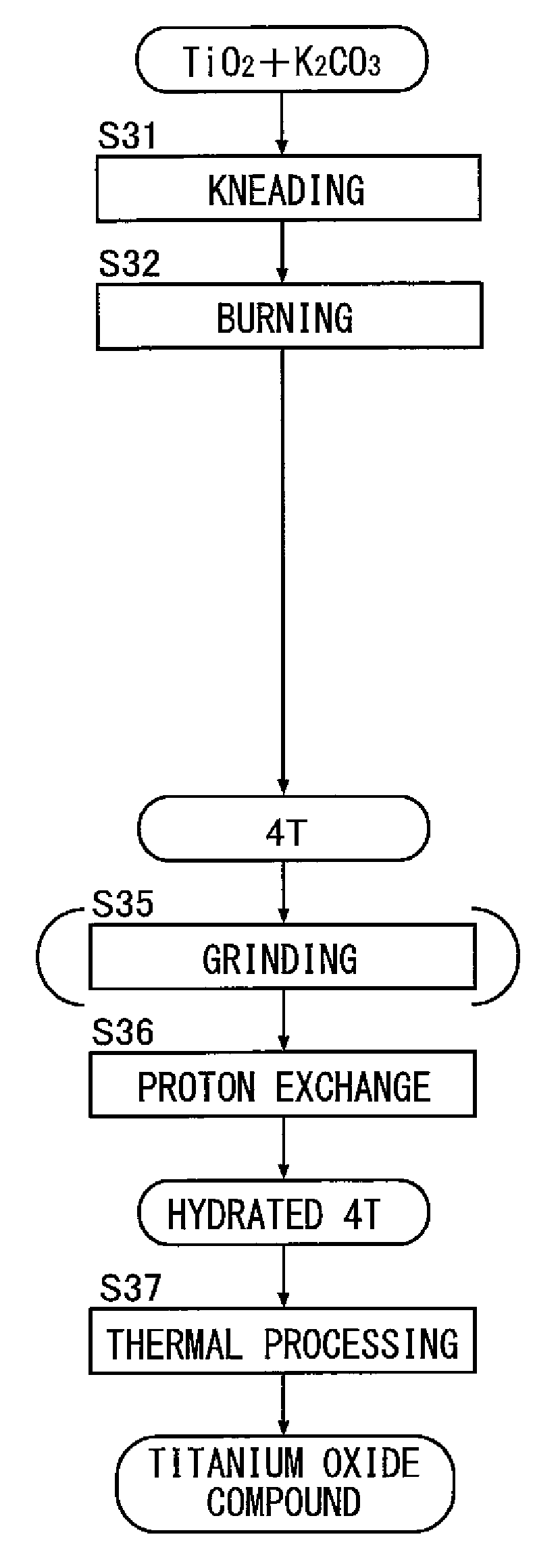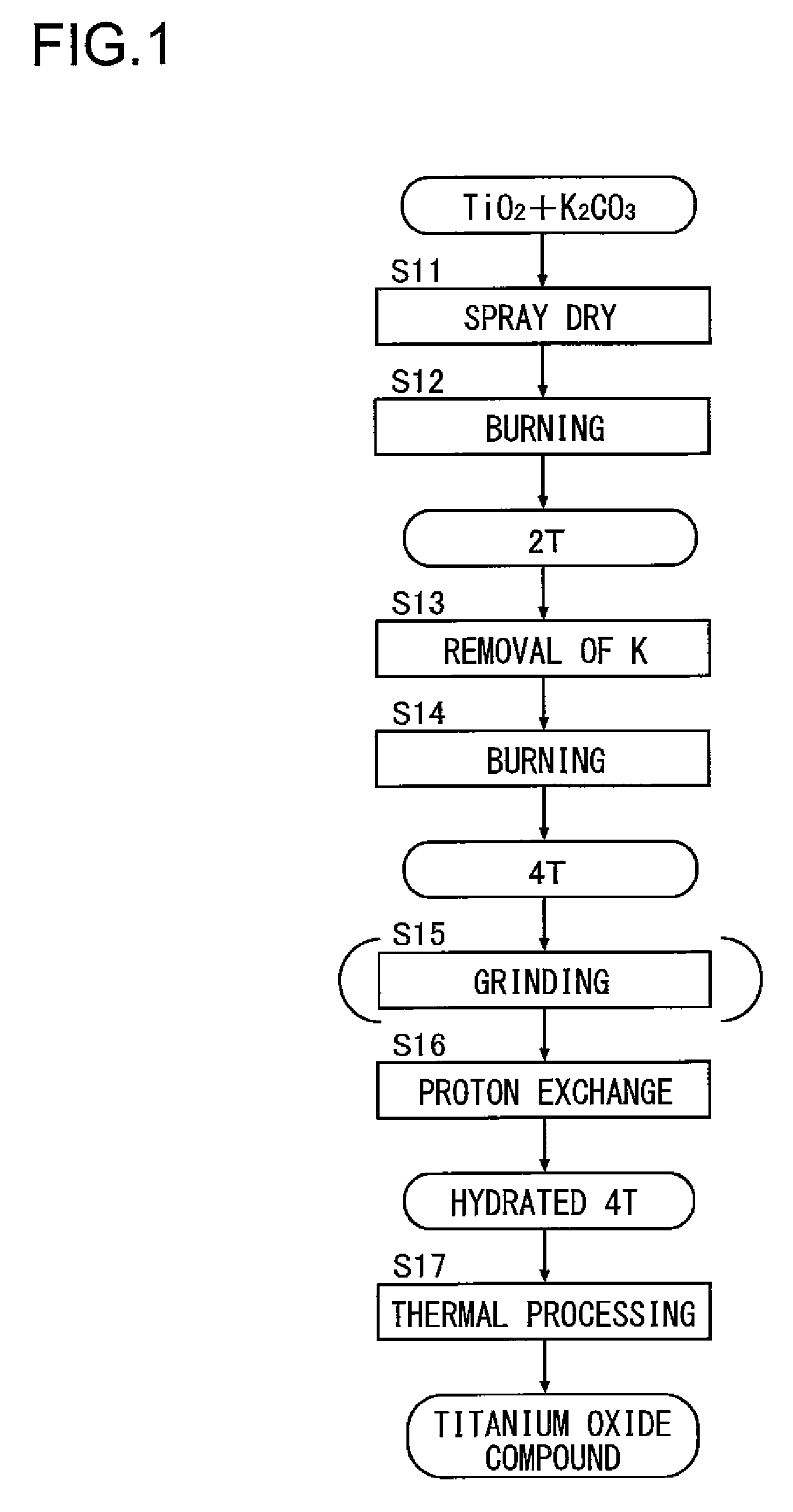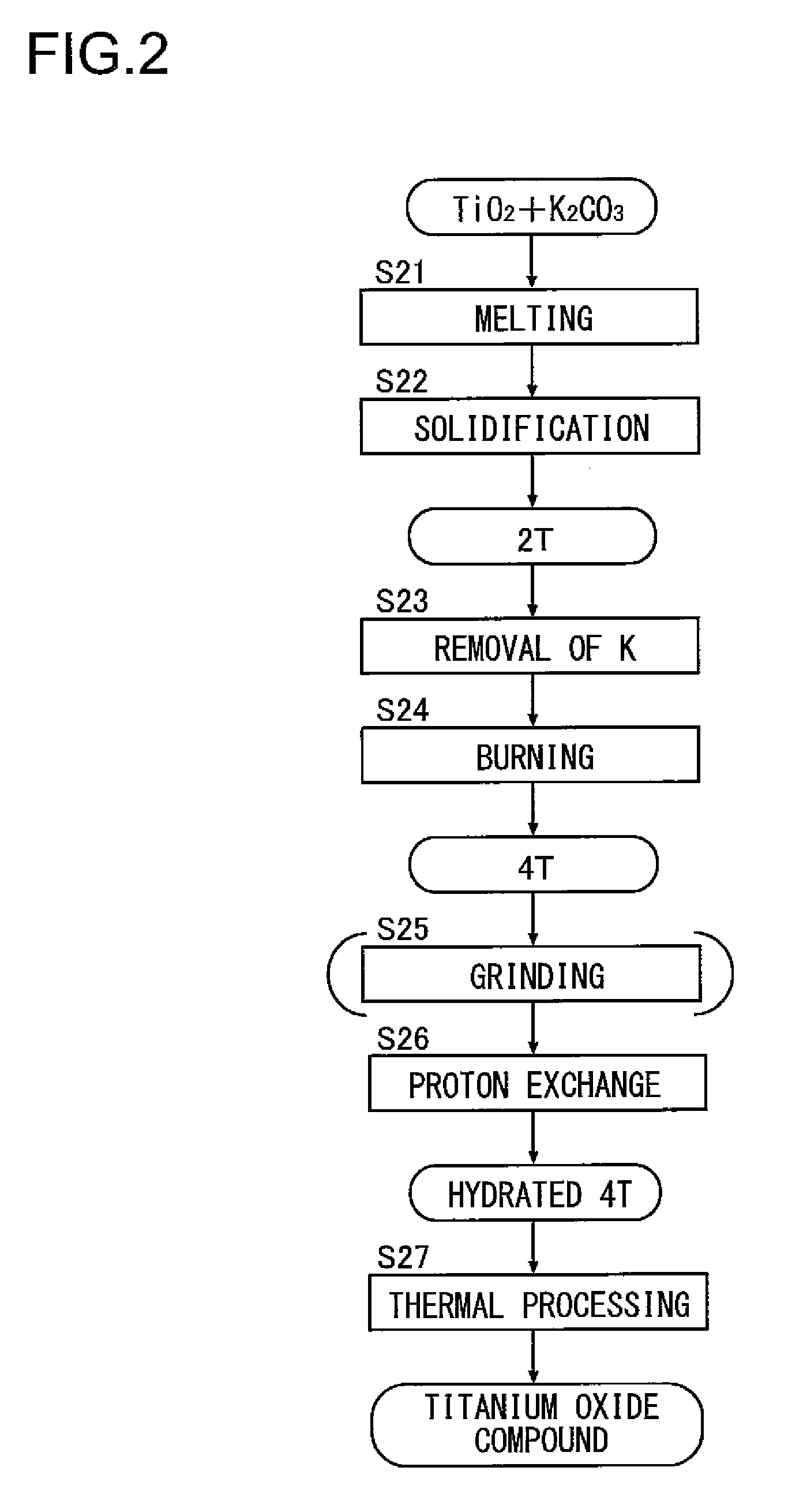Bronze-type titanium oxide compound containing potassium, method of manufacturing the same, and lithium-ion secondary battery using the same
a titanium oxide compound and titanium oxide technology, applied in the field of titanium oxide compound, can solve the problems of abnormal heat and ignition of lithium-ion secondary batteries, thermal runaway, and heat produced in negative electrodes and other members, and achieve the effect of high capacity and high safety
- Summary
- Abstract
- Description
- Claims
- Application Information
AI Technical Summary
Benefits of technology
Problems solved by technology
Method used
Image
Examples
example 1
Synthesis with the Burning Method 2T
[0077](1-1) Method of Synthesizing Potassium Dititanate (2T)
[0078]26.2 weight parts of titanium oxide (TiO2) was mixed and agitated with respect to 100 weight parts of water. Thereafter, 23.8 weight parts of potassium carbonate (K2CO3) was added and further agitated. The mixed solution was spray dried at 200° C., and was subjected to thermal processing at 800° C. for three hours, and thus potassium dititanate (K2Ti2O5) was synthesized.
[0079](1-2) Method of Synthesizing Potassium Tetratitanate (4T)
[0080]The potassium dititanate obtained by (1-1) was immersed in water and was then agitated with an agitator, and thus potassium was removed, and, after dehydration and drying, thermal processing was performed at 850° C. for two hours, and thus potassium tetratitanate (K2Ti4O9) was synthesized. The X-ray diffraction spectrum of the compound is as shown in FIG. 5 described previously; the relationship between the peak intensities Ia, Ib and Ic is as shown...
example 2
Synthesis with the Burning Method 2T
[0085](2-1) Method of Synthesizing Potassium Dititanate (2T)
[0086]Potassium dititanate was synthesized in the same step as in (1-1).
[0087](2-2) Method of Synthesizing Potassium Tetratitanate (4T)
[0088]The potassium dititanate obtained by (2-1) was immersed in water and was then agitated with an agitator after the addition of an acid, and thus potassium was removed. A supernatant thereof was removed, and then, after dehydration and drying, thermal processing was performed at 850° C. for two hours, and thus potassium tetratitanate was synthesized. The relationship between the X-ray diffraction peak intensities Ia, Ib and Ic of the compound is as shown in D2 of FIG. 8. The concentration of potassium of the compound was 19.2 mass percent as a result of composition analysis using fluorescence X-ray.
[0089](2-3) Method of Synthesizing a Hydrated Tetratitanate Compound (Hydrated 4T)
[0090]A hydrated tetratitanate compound was synthesized in the same step a...
example 3
Synthesis with the Burning Method 2T
[0093](3-1) Method of Synthesizing Potassium Dititanate (2T)
[0094]Potassium dititanate was synthesized in the same step as in (1-1).
[0095](3-2) Method of Synthesizing Potassium Tetratitanate (4T)
[0096]Potassium tetratitanate was synthesized in the same step as in (1-2).
[0097](3-3) Method of Synthesizing a Hydrated Tetratitanate Compound (Hydrated 4T)
[0098]A hydrated tetratitanate compound was synthesized in the same step as in (1-3) except that the potassium tetratitanate obtained by (3-2) was used and that the concentration of the sulfuric acid solution is changed to 1.0 M. The concentration of potassium of the compound was 0.15 mass percent as a result of composition analysis using fluorescence X-ray.
[0099](3-4) Method of Synthesizing a Titanium Oxide Compound
[0100]A titanium oxide compound was synthesized in the same step as in (1-4) except that the hydrated tetratitanate compound obtained by (3-3) was used. The concentration of potassium of th...
PUM
| Property | Measurement | Unit |
|---|---|---|
| specific surface area | aaaaa | aaaaa |
| temperatures | aaaaa | aaaaa |
| temperatures | aaaaa | aaaaa |
Abstract
Description
Claims
Application Information
 Login to View More
Login to View More - R&D
- Intellectual Property
- Life Sciences
- Materials
- Tech Scout
- Unparalleled Data Quality
- Higher Quality Content
- 60% Fewer Hallucinations
Browse by: Latest US Patents, China's latest patents, Technical Efficacy Thesaurus, Application Domain, Technology Topic, Popular Technical Reports.
© 2025 PatSnap. All rights reserved.Legal|Privacy policy|Modern Slavery Act Transparency Statement|Sitemap|About US| Contact US: help@patsnap.com



